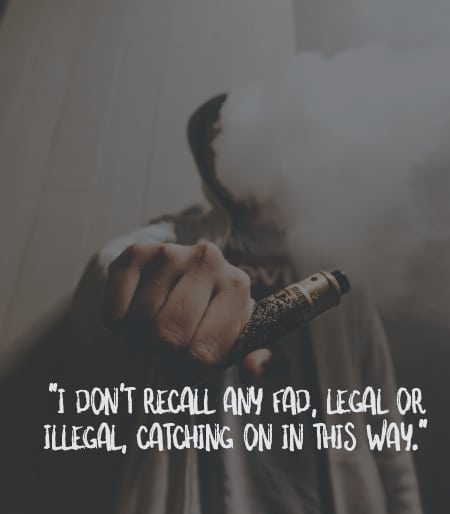It’s shaped liked a slick, high-tech device that cooks up nicotine-laced juices with playful names more commonly found in ice cream shops. The resulting aerosol tastes like gummi bears, bubble gum, or a thousand other fun flavors, is easy to inhale, and delivers a potent hit of nicotine that releases armies of dopamine neurotransmitters to which so many of us become addicted.
And while the rapid emergence of e-cigarettes or ‘vapes’ may be great news for adult smokers looking for a convenient alternative to their tobacco habit, it’s bad news – really bad news – for the millions of physically and mentally immature, deeply impressionable kids who are experimenting with these devices.
Everybody is doing it. Their parents have no idea.
“Everybody is doing it,” says a junior from a middle-class Northern Virginia high school. “They do it at home, in school, everywhere. A lot of them are doing it at home in their bedrooms. Their parents have no idea.”
Which really shouldn’t be all that surprising, given that the most popular of vapes – the Juul – is shaped like a typical computer thumb drive (in other words, easy to disguise), the resulting smoke dissipates quickly and usually smells, uh, good (again, we’re talking gummi bears, mint, mango, etc.), and the kids are taking their lead from adults, who are embracing vapes as a supposedly safer, smarter, healthier alternative to cigarettes (the jury is out on this).
But there’s a catch, and it’s a really big one: young bodies and brains are particularly vulnerable to the nicotine (and other potential nasties) flowing oh-so-smoothly from those vapes. Meaning that while adults are using vapes to kick the smoking habit, vapes are programming kids to develop one.
Sorry mom and dad, but it’s time to wake up and smell the Lava Flow, Candy Crash, or Blue Razz Lemonade, because chances are good your teen – even the one in middle school – is vaping, or soon will be.
Just How Commonplace is Vaping?
Although nobody knows for certain how many kids are vaping, one joint-CDC/FDA survey of kids found that 38% of high schoolers and 13% of middle schoolers have tried vaping. But because these numbers were volunteered by kids themselves, the actual figures are believed to be considerably higher. In other words, we’re talking millions of kids.

Another study using keyword indicators in kids’ social media messages found strong evidence of large numbers of kids Juuling “on school grounds, in classrooms, in bathrooms, in the library, at recess and during gym.” That same study found indications that some of these kids are “in elementary school.”
While Juuling is just one form of vaping – the term commonly used to describe the use of e-cigarettes – Juul today is far and away the most popular brand on the market. So much so, in fact, that Juuling has become the verb for vaping much the way Googling became synonymous with searching the Web.
So prevalent has vaping become with so many kids in so short a period of time, that even the most seasoned (and, we would assume, jaded) school administrators are shocked.
“I don’t recall any fad, legal or illegal, catching on in this way,” Meg Kenny, the assistant head of school at Burr and Burton Academy in Manchester, Vermont, told Vox. Vaping, she said, now constitutes 95% of the school’s disciplinary problems.
The Dangerous Lure of Vaping
Initially considered by many as a potential antidote to one of society’s most addictive and unhealthy habits, the growing number of kids using these devices has parents, healthcare professionals, and public policy experts deeply concerned.
Or as The New Yorker recently put it: “The potential public-health benefit of the e-cigarette is being eclipsed by the unsettling prospect of a generation of children who may really love to vape.”
And a comprehensive new report on e-cigarettes by the National Academy of Sciences isn’t likely to allay any of their concerns. While the report did conclude that e-cigarettes are less harmful than traditional cigarettes, it concluded that vaping does indeed increase the likelihood kids eventually will move on to smoking.
The potential public-health benefit of the e-cigarette is being eclipsed by the unsettling prospect of a generation of children who may really love to vape.
The report’s authors assessed 10 peer-reviewed studies and all pointed to the same conclusion. “That’s why we decided to make this conclusion much stronger,” said committee member Maciej Goniewicz, an oncologist at Roswell Park Comprehensive Cancer Center. “Children using e-cigarettes are at an increased risk of using tobacco cigarettes in the future.”
It’s also worth noting that the NAS (and others studying the issue) aren’t convinced e-cigarettes actually curb smoking.
What Parents Are Up Against
Shaped like a computer thumb drive (users actually can recharge the device by plugging it into a computer’s USB drive), Juul is easy to use – not to mention hide from nosy parents. Although e-cigarettes are illegal for minors, those restrictions have not stopped huge numbers of kids from sampling the wares.

And because they’re easier to inhale and come in all those tasty flavors, vapes are seen as particularly seductive to kids who don’t know any better and whose bodies are far more vulnerable to powerful stimulants like nicotine.
“Because nicotine has mood-elevating and addictive effects, teens who use e-cigarettes with stronger nicotine concentrations may be less willing to stop vaping and be more inclined to use other nicotine products, like conventional cigarettes,” says Adam Leventhal, director of the USC Health, Emotion and Addiction Laboratory at the Keck School of Medicine and author of a study on the effects of e-cigarettes on kids.
The most damning revelation: Within six months of the study’s start, 43% of high school students who used high-nicotine vapes became regular smokers. “We know that teens who vape e-cigarettes are much more likely to become conventional cigarette smokers,” said Leventhal. “Our study suggests that the nicotine in e-cigarettes may be a key reason why teens who vape progress to more frequent smoking.”
If you’ve never smoked and you try Juul for a few days, this is a recipe for addiction.
Which is another reason Juul has become a target of the FDA and other concerned authorities. A study comparing two Juul flavors against nine other vaping products found that the Juul juices not only were stronger in terms of the amount of nicotine delivered, but also easier to inhale.
“If you’ve never smoked and you try Juul for a few days, this is a recipe for addiction,” says David Peyton, professor of chemistry at Portland State University who, along with other researchers, tested 11 e-cigarette liquids and their aerosol contents. “You could make someone addicted who’s never been a smoker — or, for someone who is addicted to nicotine, this could be a way to get off of cigarettes.”
Equally troubling are the various subcultures growing up around vaping. Video gamers, for example, find gaming and vaping to be “a match made in heaven,” because a game no longer needs to be interrupted by smoking breaks. Hit the vape, set it down and keep on gaming. There’s now even a game whose object is for players to “vape your way through a maze of events….”
What Parents Can Do
In the same way that the lure of digital tech with kids caught parents off guard, so too are vapes requiring parents to act now if they’re to protect their kids from the dangers of vaping.

Kids, of course, are at particular risk from such threats, because their rapidly developing brains are prone to seek out the pleasure of a nicotine hit without the impulse controls necessary for gauging the associated risks.
But that’s also where the good news comes in, because kids who are made aware of risks are less likely to engage in dangerous activities. “In experiments where the probabilities of their risks are known, adolescents take fewer risks than children,” says Dan Romer, Research Director, Annenberg Public Policy Center, University of Pennsylvania.
To Romer and experts like him, the challenge facing children and, in particular, teens, isn’t so much their lack of control, but the absence of wisdom that comes through experience.
Parents can help their kids develop some of that wisdom by spending lots of time with their kids, by talking to them about their developing bodies and brains, and by keeping them engaged in healthier pursuits that deliver a natural high vs. one that comes from a vape.
